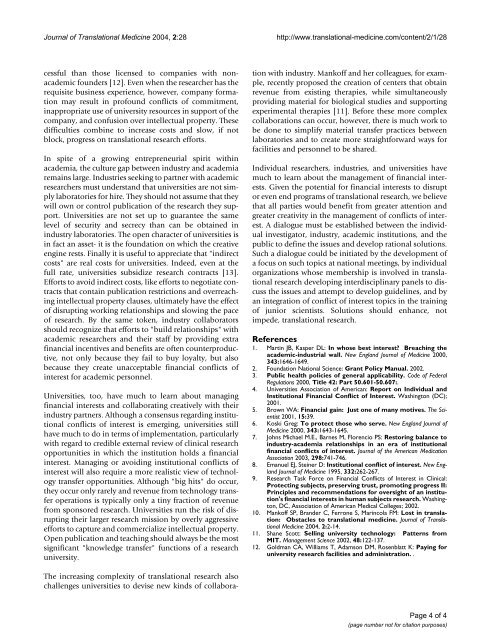Conflicts of interest in translational research
Conflicts of interest in translational research
Conflicts of interest in translational research
- No tags were found...
You also want an ePaper? Increase the reach of your titles
YUMPU automatically turns print PDFs into web optimized ePapers that Google loves.
Journal <strong>of</strong> Translational Medic<strong>in</strong>e 2004, 2:28http://www.<strong>translational</strong>-medic<strong>in</strong>e.com/content/2/1/28cessful than those licensed to companies with nonacademicfounders [12]. Even when the <strong>research</strong>er has therequisite bus<strong>in</strong>ess experience, however, company formationmay result <strong>in</strong> pr<strong>of</strong>ound conflicts <strong>of</strong> commitment,<strong>in</strong>appropriate use <strong>of</strong> university resources <strong>in</strong> support <strong>of</strong> thecompany, and confusion over <strong>in</strong>tellectual property. Thesedifficulties comb<strong>in</strong>e to <strong>in</strong>crease costs and slow, if notblock, progress on <strong>translational</strong> <strong>research</strong> efforts.In spite <strong>of</strong> a grow<strong>in</strong>g entrepreneurial spirit with<strong>in</strong>academia, the culture gap between <strong>in</strong>dustry and academiarema<strong>in</strong>s large. Industries seek<strong>in</strong>g to partner with academic<strong>research</strong>ers must understand that universities are not simplylaboratories for hire. They should not assume that theywill own or control publication <strong>of</strong> the <strong>research</strong> they support.Universities are not set up to guarantee the samelevel <strong>of</strong> security and secrecy than can be obta<strong>in</strong>ed <strong>in</strong><strong>in</strong>dustry laboratories. The open character <strong>of</strong> universities is<strong>in</strong> fact an asset- it is the foundation on which the creativeeng<strong>in</strong>e rests. F<strong>in</strong>ally it is useful to appreciate that "<strong>in</strong>directcosts" are real costs for universities. Indeed, even at thefull rate, universities subsidize <strong>research</strong> contracts [13].Efforts to avoid <strong>in</strong>direct costs, like efforts to negotiate contractsthat conta<strong>in</strong> publication restrictions and overreach<strong>in</strong>g<strong>in</strong>tellectual property clauses, ultimately have the effect<strong>of</strong> disrupt<strong>in</strong>g work<strong>in</strong>g relationships and slow<strong>in</strong>g the pace<strong>of</strong> <strong>research</strong>. By the same token, <strong>in</strong>dustry collaboratorsshould recognize that efforts to "build relationships" withacademic <strong>research</strong>ers and their staff by provid<strong>in</strong>g extraf<strong>in</strong>ancial <strong>in</strong>centives and benefits are <strong>of</strong>ten counterproductive,not only because they fail to buy loyalty, but alsobecause they create unacceptable f<strong>in</strong>ancial conflicts <strong>of</strong><strong><strong>in</strong>terest</strong> for academic personnel.Universities, too, have much to learn about manag<strong>in</strong>gf<strong>in</strong>ancial <strong><strong>in</strong>terest</strong>s and collaborat<strong>in</strong>g creatively with their<strong>in</strong>dustry partners. Although a consensus regard<strong>in</strong>g <strong>in</strong>stitutionalconflicts <strong>of</strong> <strong><strong>in</strong>terest</strong> is emerg<strong>in</strong>g, universities stillhave much to do <strong>in</strong> terms <strong>of</strong> implementation, particularlywith regard to credible external review <strong>of</strong> cl<strong>in</strong>ical <strong>research</strong>opportunities <strong>in</strong> which the <strong>in</strong>stitution holds a f<strong>in</strong>ancial<strong><strong>in</strong>terest</strong>. Manag<strong>in</strong>g or avoid<strong>in</strong>g <strong>in</strong>stitutional conflicts <strong>of</strong><strong><strong>in</strong>terest</strong> will also require a more realistic view <strong>of</strong> technologytransfer opportunities. Although "big hits" do occur,they occur only rarely and revenue from technology transferoperations is typically only a t<strong>in</strong>y fraction <strong>of</strong> revenuefrom sponsored <strong>research</strong>. Universities run the risk <strong>of</strong> disrupt<strong>in</strong>gtheir larger <strong>research</strong> mission by overly aggressiveefforts to capture and commercialize <strong>in</strong>tellectual property.Open publication and teach<strong>in</strong>g should always be the mostsignificant "knowledge transfer" functions <strong>of</strong> a <strong>research</strong>university.The <strong>in</strong>creas<strong>in</strong>g complexity <strong>of</strong> <strong>translational</strong> <strong>research</strong> alsochallenges universities to devise new k<strong>in</strong>ds <strong>of</strong> collaborationwith <strong>in</strong>dustry. Mank<strong>of</strong>f and her colleagues, for example,recently proposed the creation <strong>of</strong> centers that obta<strong>in</strong>revenue from exist<strong>in</strong>g therapies, while simultaneouslyprovid<strong>in</strong>g material for biological studies and support<strong>in</strong>gexperimental therapies [11]. Before these more complexcollaborations can occur, however, there is much work tobe done to simplify material transfer practices betweenlaboratories and to create more straightforward ways forfacilities and personnel to be shared.Individual <strong>research</strong>ers, <strong>in</strong>dustries, and universities havemuch to learn about the management <strong>of</strong> f<strong>in</strong>ancial <strong><strong>in</strong>terest</strong>s.Given the potential for f<strong>in</strong>ancial <strong><strong>in</strong>terest</strong>s to disruptor even end programs <strong>of</strong> <strong>translational</strong> <strong>research</strong>, we believethat all parties would benefit from greater attention andgreater creativity <strong>in</strong> the management <strong>of</strong> conflicts <strong>of</strong> <strong><strong>in</strong>terest</strong>.A dialogue must be established between the <strong>in</strong>dividual<strong>in</strong>vestigator, <strong>in</strong>dustry, academic <strong>in</strong>stitutions, and thepublic to def<strong>in</strong>e the issues and develop rational solutions.Such a dialogue could be <strong>in</strong>itiated by the development <strong>of</strong>a focus on such topics at national meet<strong>in</strong>gs, by <strong>in</strong>dividualorganizations whose membership is <strong>in</strong>volved <strong>in</strong> <strong>translational</strong><strong>research</strong> develop<strong>in</strong>g <strong>in</strong>terdiscipl<strong>in</strong>ary panels to discussthe issues and attempt to develop guidel<strong>in</strong>es, and byan <strong>in</strong>tegration <strong>of</strong> conflict <strong>of</strong> <strong><strong>in</strong>terest</strong> topics <strong>in</strong> the tra<strong>in</strong><strong>in</strong>g<strong>of</strong> junior scientists. Solutions should enhance, notimpede, <strong>translational</strong> <strong>research</strong>.References1. Mart<strong>in</strong> JB, Kasper DL: In whose best <strong><strong>in</strong>terest</strong>? Breach<strong>in</strong>g theacademic-<strong>in</strong>dustrial wall. New England Journal <strong>of</strong> Medic<strong>in</strong>e 2000,343:1646-1649.2. Foundation National Science: Grant Policy Manual. 2002.3. Public health policies <strong>of</strong> general applicability. Code <strong>of</strong> FederalRegulations 2000, Title 42: Part 50.601-50.607:.4. Universities Association <strong>of</strong> American: Report on Individual andInstitutional F<strong>in</strong>ancial Conflict <strong>of</strong> Interest. Wash<strong>in</strong>gton (DC);2001.5. Brown WA: F<strong>in</strong>ancial ga<strong>in</strong>: Just one <strong>of</strong> many motives. The Scientist2001, 15:39.6. Koski Greg: To protect those who serve. New England Journal <strong>of</strong>Medic<strong>in</strong>e 2000, 343:1643-1645.7. Johns Michael M.E., Barnes M, Florencio PS: Restor<strong>in</strong>g balance to<strong>in</strong>dustry-academia relationships <strong>in</strong> an era <strong>of</strong> <strong>in</strong>stitutionalf<strong>in</strong>ancial conflicts <strong>of</strong> <strong><strong>in</strong>terest</strong>. Journal <strong>of</strong> the American MedicationAssociation 2003, 298:741-746.8. Emanuel EJ, Ste<strong>in</strong>er D: Institutional conflict <strong>of</strong> <strong><strong>in</strong>terest</strong>. New EnglandJournal <strong>of</strong> Medic<strong>in</strong>e 1995, 332:262-267.9. Research Task Force on F<strong>in</strong>ancial <strong>Conflicts</strong> <strong>of</strong> Interest <strong>in</strong> Cl<strong>in</strong>ical:Protect<strong>in</strong>g subjects, preserv<strong>in</strong>g trust, promot<strong>in</strong>g progress II:Pr<strong>in</strong>ciples and recommendations for oversight <strong>of</strong> an <strong>in</strong>stitution'sf<strong>in</strong>ancial <strong><strong>in</strong>terest</strong>s <strong>in</strong> human subjects <strong>research</strong>. Wash<strong>in</strong>gton,DC, Association <strong>of</strong> American Medical Colleges; 2002.10. Mank<strong>of</strong>f SP, Brander C, Ferrone S, Mar<strong>in</strong>cola FM: Lost <strong>in</strong> translation:Obstacles to <strong>translational</strong> medic<strong>in</strong>e. Journal <strong>of</strong> TranslationalMedic<strong>in</strong>e 2004, 2:2-14.11. Shane Scott: Sell<strong>in</strong>g university technology: Patterns fromMIT. Management Science 2002, 48:122-137.12. Goldman CA, Williams T, Adamson DM, Rosenblatt K: Pay<strong>in</strong>g foruniversity <strong>research</strong> facilities and adm<strong>in</strong>istration. .Page 4 <strong>of</strong> 4(page number not for citation purposes)










